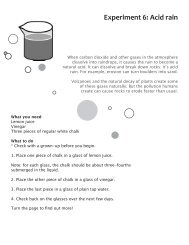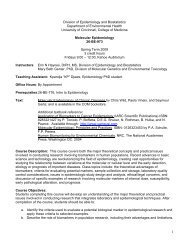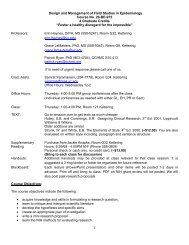[3] Categorical Data Analysis, Alan Agresti, 2002, John Wiley.
[3] Categorical Data Analysis, Alan Agresti, 2002, John Wiley.
[3] Categorical Data Analysis, Alan Agresti, 2002, John Wiley.
- No tags were found...
You also want an ePaper? Increase the reach of your titles
YUMPU automatically turns print PDFs into web optimized ePapers that Google loves.
GOAL OF COURSE26-BE-797, FALL 2010CATEGORICAL DATA ANALYSIS/LOGISTIC REGRESSIONSYLLABUS<strong>Categorical</strong> analysis will be covered in the first half of the course; the second half will cover logisticregression analysis. The course will introduce students to the most important methods for analyzingcategorical data such as chi-squared tests, and will also include specialized methods for ordinal data,small samples, multi-category data and matched pairs. Logistic regression modeling of binary datawill be presented in detail. Implementation of methods and application to data analysis will be thefocus of the course. A special feature is the inclusion of a unified perspective, based on generalizedlinear models, that connects the analysis of binary data with standard regression models for normallydistributed data. The contents of course lectures will be cumulative.INSTRUCTORLinda Levin, PhDOffice: G25 Kettering laboratory, 558-0050, linda.levin@uc.eduOffice hours by appointmentLECTURE TIMEST F 9:30-11:00, Room 121, Kettering LaboratoryTextsLecture notes posted on BlackboardOptional Texts[1]* Logistic Regression Examples Using the SAS System, Version 6, First Edition. SAS Institute;SAS Publishing. Available online at http://www.amazon.com/Logistic-Regression-Examples-System-Version/dp/1555446744. The cost is $23.00 plus shipping. Fororders that exceed $25.00, shipping is free.[2] Logistic Regression, A Self-Learning Text, David G. Kleinbaum and Mitchell Klein (2 nd ed.),Springer.[3] <strong>Categorical</strong> <strong>Data</strong> <strong>Analysis</strong>, <strong>Alan</strong> <strong>Agresti</strong>, <strong>2002</strong>, <strong>John</strong> <strong>Wiley</strong>.[4] Applied Logistic Regression, David Hosmer & Stanley Lemeshow, <strong>John</strong> <strong>Wiley</strong>.* Recommended for students who are new SAS usersPREREQUISITEIntroduction to Biostatistics 26-BE-787 or equivalent. Thus, students should be familiar with basicnotions of probability, random variables, and statistical inference. The course involves the use of theSAS (Statistical <strong>Analysis</strong> System); students are expected to have had some exposure to the use ofSAS. The underlying mathematical theory will not be stressed; the main focus will be on concepts and
applications. Please contact the instructor if you have questions about the suitability of yourbackground.COURSE CONDUCTLectures: We will follow lecture notes provided by the instructor. Most lectures will be posted on theBLACKBOARD system (accessible upon registration); others will be handed out in class. Bring notesfor current lecture to class and lab sessions.Homework: There will be two homework assignments, both in the first half of the course. Studentsshould work alone, and each student must show the work and/or write programs and write up the finalsolutions to all problems independently. No “blind copying" permitted.Tentative homework due dates: 10/12, 10/26Computing: Students may use SAS on the university server. Alternatively, students with access toSAS somewhere else may use whatever system is most convenient. Please see the instructor if youhave any questions. All data sets to be analyzed will be available on BLACKBOARD.<strong>Categorical</strong> <strong>Analysis</strong> Mid-term Exam Date: October 29 during scheduled class time.Final Exam Date: No final exam. A logistic regression data analysis project will serve as a finalexam. The approximate due date is Monday, December 13.<strong>Data</strong> <strong>Analysis</strong> Project: Students will carry out an analysis of data collected in a study which will bedescribed. They will be expected to formalize the scientific questions, carry out the appropriateanalyses, interpret the results, and write a comprehensive report on all of these activities. The projectwill be posted on BLACKBOARD on approximately Nov 3 and will be due on Monday, December13. More details on the project will be provided later in the course.Grading: The course grade will be determined according to the following breakdown: homework15%, mid-term 40%, final project 40%, instructor’s discretion 5%. The instructor’s discretion portionwill be based on attendance, participation in class, an instructor’s assessment of mastery of material.Conversion of these scores into letter grades will be made according to the following (the upper scorein each range belongs to the next highest grade): A,92-100; A-,90-92; B+,86-90; B,79-86; B-,75-79;C, 70-75. Scores below 70 will be handled on a case-by-case basis. The grade of A+ will be given atthe discretion of the instructor for truly stellar individual performance. Depending on overall classperformance, these ranges may be adjusted (but only downward-criteria will only become easier, notharder).


![[3] Categorical Data Analysis, Alan Agresti, 2002, John Wiley.](https://img.yumpu.com/44435591/1/500x640/3-categorical-data-analysis-alan-agresti-2002-john-wiley.jpg)







